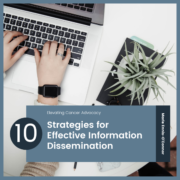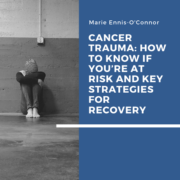Elevating Cancer Advocacy: 10 Strategies for Effective Information Dissemination
As patient advocates we not only want to educate and support cancer research and awareness, but we also want to inspire hope. In this month’s article, I discuss 10 types of content that can help you communicate and disseminate information, advance cancer advocacy, and encourage and empower those affected by cancer.
1. Treatment Journey Timelines
Share informative timelines outlining the typical journey of a cancer patient from diagnosis to treatment and recovery.
What to share:
- Key information about surgery, chemotherapy, radiation therapy, immunotherapy, and any other pertinent treatments.
- Highlight the importance of support systems during treatment.
- Address the common side effects associated with different treatments.
- Include images that highlight the various stages of the journey, from diagnosis and treatment to recovery, providing a visual timeline of the cancer experience.
- Conclude the timeline by exploring the phase of life after active treatment.
2. Visual Content
Use graphics, videos, or infographics to make your content more visually appealing The human brain processes visual information much faster than text, making visual content not only more engaging but also more memorable. In addition to enhancing understanding and engagement, visual content is more likely to be shared across various social media platforms. People are more likely to share visually appealing and informative content with their networks, contributing to the dissemination of important medical information.
What to share:
- Make complex concepts more accessible and easier to understand with infographics.
- Live video streaming can be used to host interactive Q&A sessions and webinars with experts in the field who can answer questions and provide valuable insights. This real-time interaction provides valuable information as well as a more engaging experience for your audience.
3. Personal Stories
Use written narratives, images, and video testimonials to describe the emotional and physical effects of being diagnosed with cancer.
What to share:
- Explore the emotional roller coaster you experienced, detailing the shock, anxiety, and uncertainty that often accompany a diagnosis of cancer.
- Share images that capture the visual aspects of the cancer journey.
- Offer practical advice on managing the physical side effects of cancer treatment, such as nausea.
- Share a range of coping strategies such as mindfulness techniques, support group recommendations, and mental health resources.
- Highlight the importance of seeking professional counseling and the value of connecting with others who have faced similar challenges.
- Acknowledge the ongoing challenges survivors may face, such as mental health concerns, or a fear of recurrence.
- Offer words of encouragement and messages of hope. Remind others that they are not alone in their journey and that strength can be found in community and shared experiences.
4. Cancer Prevention Tips
As a cancer advocate, your aim is not only to raise awareness but also to empower others with practical advice that promotes a proactive approach to wellness and reduces the risk of cancer.
What to share:
- Address common misconceptions surrounding diet and cancer, discussing evidence-based findings on the impact of various foods on cancer risk.
- Provide practical tips on incorporating a balanced and cancer-preventive diet, emphasizing the importance of fruits, vegetables, whole grains, and lean proteins.
- Provide actionable advice on incorporating regular exercise into daily routines, catering to various fitness levels and preferences.
- Outline recommended screening guidelines for various types of cancer, stressing the importance of regular check-ups and screenings based on age, gender, and family history.
- Collaborate with oncologists, researchers, and other cancer experts to discuss recent research findings related to cancer prevention. Address emerging trends, breakthroughs, and advancements in the field, providing your audience with up-to-date and credible information.
5. Clinical Trial Information
Clinical trials often explore novel treatments that may be more effective than standard therapies. By sharing information about ongoing trials, you can open doors for patients to access innovative and potentially transformative medical interventions.
What to share:
- Start by providing educational content that explains the concept of clinical trials, their purpose, and their significance in advancing medical research. Break down the different phases of clinical trials, emphasizing how they contribute to the development of new treatments.
- Acknowledge common concerns and misconceptions surrounding clinical trials, such as fear of receiving a placebo, uncertainty about side effects, or worries about being treated as a “guinea pig.” Provide clear, factual information to address these concerns and build trust in the clinical trial process.
- Ensure that information is easily accessible to patients. Create user-friendly resources that list ongoing trials, their eligibility criteria, and contact information for trial coordinators.
- Stress the importance of informed decision-making when considering participation in a clinical trial. Provide resources that guide patients on questions to ask, considerations to weigh, and how to engage in meaningful conversations with their healthcare team.
- Emphasize the importance of diverse participation in clinical trials. Advocate for increased representation of various demographics to ensure that trial results are applicable to a broader population.
- Establish partnerships with oncologists, nurses, research institutions, universities, and medical centers conducting clinical trials. Collaborate to amplify the reach of trial information and ensure that advocates are well-informed about the latest developments.
6. Legislation and Policy Updates
By sharing legislative changes related to cancer research funding, healthcare policies, and patient rights, you can empower individuals facing a cancer diagnosis, ensuring that they are aware of their rights and can actively participate in their treatment decisions.
What to share:
- Advocate for legislation that safeguards patient privacy. Stress the significance of maintaining the confidentiality of medical information and protecting patient data in the digital age. Help your audience understand their rights regarding the privacy of their health information.
- Advocate for legislation that supports and emphasizes the active participation of patients in their treatment decisions. Share information on laws that empower patients to be partners in their healthcare journey, fostering a collaborative relationship with their healthcare providers.
- Advocate for initiatives that promote transparent communication between healthcare providers and patients. Stress the importance of clear and understandable information, ensuring that patients have the knowledge needed to make informed choices about their care.
7. Conference Reports
Conference reporting facilitates the dissemination of the latest research, treatment updates, and policy discussions to a broader audience, which is a crucial aspect of cancer advocacy.
What to share:
- Summaries of key sessions and presentations. Highlight significant findings, breakthroughs, and advancements in cancer research, treatment, and patient care.
- Livetweet important points, quotes, and visuals to engage a wider audience.
- Conduct interviews with keynote speakers, researchers, healthcare professionals, and fellow advocates. Gather their perspectives on emerging trends, challenges, and opportunities in the field of cancer.
- Ensure that your conference reports are accessible to a diverse audience. Use clear language, provide explanations for technical terms, and consider different formats to accommodate various learning styles and preferences.
8. Cancer Awareness Days, Weeks, and Months
Compile a list of key cancer-related awareness days, weeks, or months throughout the year. These designated days are important for educating the public, destigmatizing the disease, and advocating for essential research funding. Integrate these awareness days into your content calendar, dedicating specific time frames for planning, creating, and promoting content around each designated date.
What to share
- Highlight significant dates such as World Cancer Day on February 4th, National Cancer Prevention Month, Breast Cancer Awareness Month, etc.
- Plan focused campaigns during these dates, leveraging relevant hashtags and encouraging your audience to participate.
- Develop a variety of content types, including articles, infographics, videos, and social media posts, to cater to different audience preferences. Ensure that your content is informative, emotionally resonant, and shareable.
- Use relevant hashtags associated with each awareness day.
- Provide educational resources including fact sheets, downloadable guides, and links to reputable sources. Empower your audience with accurate information to promote understanding and dispel myths.
9. Think Beyond Cancer
Thinking beyond cancer-specific days and aligning your advocacy efforts with impactful occasions like International Women’s Day can broaden the scope of your message and connect with a wider audience.
What to share:
- International Women’s Day (March 8th): Highlight the impact of cancer on women’s health, emphasizing gender-specific cancers and advocating for gender equality in cancer research, treatment, and support.
- International Day of Yoga (June 21st): Share information on how activities like yoga can complement cancer treatment, alleviate stress, and improve overall well-being.
- World Mental Health Day (October 10th): Address the impact of cancer on mental health. Provide resources on coping strategies, discuss emotional aspects of cancer journeys, and advocate for increased mental health support.
- World No Alcohol Day (October 2nd): Share information on the link between alcohol consumption and certain cancers, encouraging responsible drinking habits to reduce cancer risk.
- World Osteoporosis Day (October 20th): Address the impact of certain cancer treatments on bone health. Provide information on how cancer survivors can maintain bone health and prevent osteoporosis.
9. Interactive Content
By incorporating interactive content, such as online polls, information can be shared in a more dynamic and engaging way. Audiences are not only educated but also engaged and mobilized through a two-way interaction.
What to share:
- Turn cancer awareness into an interactive learning experience by crafting polls that function as educational quizzes. Ask participants about cancer-related risk factors, symptoms, or prevention methods, providing instant feedback and valuable insights.
- Combat misinformation and address stigma by using polls to confront prevalent myths about cancer. Create questions that challenge misconceptions, enabling participants to contribute to dispelling stereotypes and fostering a more informed and empathic online community.
- Extend the impact of interactive content by promoting cross-platform engagement. Encourage followers to share poll results on various social media channels, multiplying the reach of awareness initiatives and fostering organic conversations about cancer-related topics.
I hope you’ve found these content suggestions helpful. Implementing these ideas can not only raise awareness about cancer but also inspire action, foster community, and contribute significantly to the advancement of cancer advocacy.
You might also like to read

A Stanford Medicine X e-Patient scholar, Marie Ennis O’Connor is an internationally recognized keynote speaker, writer, and consultant on global trends in patient engagement, digital health and participatory medicine. Marie’s work is informed by her passion for embedding the patient voice at the heart of healthcare values. She writes about the experience of transitioning from breast cancer patient to advocate on her award-winning blog Journeying Beyond Breast Cancer.










